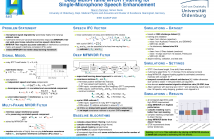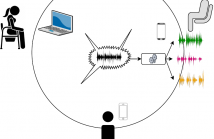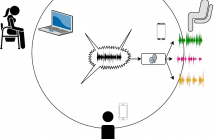
- Read more about Deep Multi-Frame MVDR Filtering for Single-Microphone Speech Enhancement -- Poster
- Log in to post comments
Multi-frame algorithms for single-microphone speech enhancement, e.g., the multi-frame minimum variance distortionless response (MFMVDR) filter, are able to exploit speech correlation across adjacent time frames in the short-time Fourier transform (STFT) domain. Provided that accurate estimates of the required speech interframe correlation vector and the noise correlation matrix are available, it has been shown that the MFMVDR filter yields a substantial noise reduction while hardly introducing any speech distortion.
- Categories:
 51 Views
51 Views
- Read more about DISTRIBUTED SPEECH SEPARATION IN SPATIALLY UNCONSTRAINED MICROPHONE ARRAYS
- Log in to post comments
- Categories:
 11 Views
11 Views
- Read more about DISTRIBUTED SPEECH SEPARATION IN SPATIALLY UNCONSTRAINED MICROPHONE ARRAYS
- 1 comment
- Log in to post comments
- Categories:
 14 Views
14 Views
- Read more about ICASSP 2021 Poster - SPARSE RECOVERY BEAMFORMING AND UPSCALING IN THE RAY SPACE
- Log in to post comments
We have been exploring the integration of sparse recovery methods into the ray space transform over the past years and now demonstrate the potential and benefits of beamforming and upscaling signals in the integrated ray space and sparse recovery domain. A primary advantage of the ray space approach derives from its robust ability to integrate information from multiple arrays and viewpoints. Nonetheless, for a given viewpoint, the ray space technique requires a dense array that can be divided into sub-arrays enabling the plenacoustic approach to signal processing.
- Categories:
 18 Views
18 Views
- Read more about On Permutation Invariant Training for Speech Source Separation
- Log in to post comments
poster.pdf
- Categories:
 2 Views
2 Views- Read more about Complex NMF under phase constraints based on signal modeling
- Log in to post comments
Nonnegative Matrix Factorization (NMF) is a powerful tool for decomposing mixtures of audio signals in the Time-Frequency (TF) domain. In the source separation framework, the phase recovery for each extracted component is necessary for synthesizing time-domain signals. The Complex NMF (CNMF) model aims to jointly estimate the spectrogram and the phase of the sources, but requires to constrain the phase in order to produce satisfactory sounding results.
icassp2016_slides.pdf
- Categories:
 7 Views
7 Views- Read more about Phase-dependent anisotropic Gaussian model for audio source separation
- Log in to post comments
Phase reconstruction of complex components in the time-frequency domain is a challenging but necessary task for audio source separation. While traditional approaches do not exploit phase constraints that originate from signal modeling, some prior information about the phase can be obtained from sinusoidal modeling. In this paper, we introduce a probabilistic mixture model which allows us to incorporate such phase priors within a source separation framework.
2017_icassp.pdf
- Categories:
 16 Views
16 Views
- Read more about Online spectrogram inversion for low-latency audio source separation
- Log in to post comments
Audio source separation is usually achieved by estimating the short-time Fourier transform (STFT) magnitude of each source, and then applying a spectrogram inversion algorithm to retrieve time-domain signals. In particular, the multiple input spectrogram inversion (MISI) algorithm has been exploited successfully in several recent works. However, this algorithm suffers from two drawbacks, which we address in this paper.
- Categories:
 24 Views
24 Views